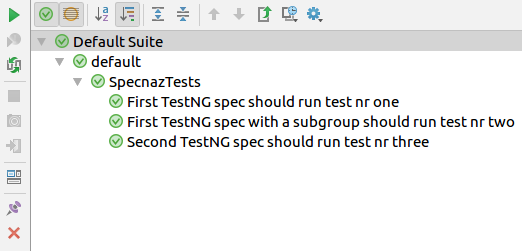Specnaz 1.4 released!
1.4 is the newest release of Specnaz, my testing library for Java, Kotlin and Groovy. This version ships with the number one requested feature for Specnaz – supporting TestNG in addition to JUnit as the test execution and reporting engine.
TestNG in Java
To use the TestNG support, you need to, first of all, depend on the new specnaz-testng module instead of specnaz-junit.
Then, your spec class needs to implement the SpecnazFactoryTestNG interface from the org.specnaz.testng package.
It extends the “regular” Specnaz interface, and like it it contains one default
(that is, containing an implementation) method,
so you don’t need to write any additional code in your spec class to implement it.
Your spec class also needs to be annotated with TestNG’s @Test annotation.
Other than that, TestNG specs look exactly like other Specnaz tests: you call the describes method in your class’s public, no-argument constructor, passing your specification in the form of a lambda expression as the second parameter to describes. Example:
import org.specnaz.testng.SpecnazFactoryTestNG;
import org.testng.Assert;
import org.testng.annotations.Test;
import java.util.Stack;
@Test
public class StackSpec implements SpecnazFactoryTestNG {{
describes("A Stack", it -> {
Stack stack = new Stack<>();
it.endsEach(() -> {
stack.clear();
});
it.should("be empty when first created", () -> {
Assert.assertTrue(stack.isEmpty());
});
it.describes("with 10 and 20 pushed on it", () -> {
it.beginsEach(() -> {
stack.push(10);
stack.push(20);
});
it.should("have size equal to 2", () -> {
Assert.assertEquals(stack.size(), 2);
});
it.should("have 20 as the top element", () -> {
Assert.assertEquals((int) stack.peek(), 20);
});
});
});
}}
Naturally, you can also write parametrized tests in TestNG –
the only difference is that you need to implement the SpecnazParamsFactoryTestNG interface
from the org.specnaz.params.testng package instead of SpecnazFactoryTestNG.
TestNG in Kotlin
Kotlin support for TestNG is very similar.
There’s an equivalent of the SpecnazFactoryTestNG interface,
SpecnazKotlinFactoryTestNG,
in the org.specnaz.kotlin.testng package.
There’s also an abstract class that’s equivalent to SpecnazKotlinJUnit:
SpecnazKotlinTestNG, in the org.specnaz.kotlin.testng package,
which implements SpecnazKotlinFactoryTestNG,
and calls the describes method in its primary constructor.
Which means you can save some boilerplate, and one level of indentation,
if your test class doesn’t need to extend a particular class
(note that you still need to annotate your spec class with TestNG’s @Test annotation):
import org.specnaz.kotlin.testng.SpecnazKotlinTestNG
import org.testng.Assert
import org.testng.annotations.Test
import java.util.Stack
@Test
class StackSpec : SpecnazKotlinTestNG("A Stack", {
var stack = Stack<Int>()
it.endsEach {
stack = Stack()
}
it.should("be empty when first created") {
Assert.assertTrue(stack.isEmpty())
}
it.describes("with 10 and 20 pushed on it") {
it.beginsEach {
stack.push(10)
stack.push(20)
}
it.should("have size equal to 2") {
Assert.assertEquals(stack.size, 2)
}
it.should("have 20 as the top element") {
Assert.assertEquals(stack.peek(), 20)
}
}
})
Similarly for parametrized TestNG Kotlin specs –
you have the SpecnazKotlinParamsFactoryTestNG interface in the org.specnaz.kotlin.params.testng package,
and the SpecnazKotlinParamsTestNG abstract helper class in the same package.
TestNG limitations
Sadly, TestNG is not as flexible as JUnit, and has some inherent limitations when being used as the test execution engine for Specnaz:
- TestNG doesn’t support the same arbitrary test results trees as JUnit – which means the reports will be flattened, regardless of the level of nesting in your specs. The reported name of each test will be all of descriptions, up to the root of the spec tree, concatenated with the test’s own description.
- All of the results will be reported under one root class,
SpecnazTests, in theorg.specnaz.testngpackage, completely discarding the original name of your spec class.
So, let’s say you have the following test suite, consisting of 2 classes:
@Test
public class FirstSpec implements SpecnazFactoryTestNG {{
describes("First TestNG spec", it -> {
it.should("run test nr one", () -> {
// test body here...
});
it.describes("with a subgroup", () -> {
it.should("run test nr two", () -> {
// test body here...
});
});
});
}}
@Test
public class SecondSpec implements SpecnazFactoryTestNG {{
describes("Second TestNG spec", it -> {
it.should("run test nr three", () -> {
// test body here...
});
});
}}
Executing this test suite will produce a result looking something like this:

As you can see, the spec tree structure is not preserved in the results, unlike with JUnit, and the names of the spec classes are gone, replaced with SpecnazTests. Unfortunately, these are artifacts of how TestNG is organized internally, and there is nothing Specnaz can do to correct these.
Summary
Like I said, TestNG support was the single most requested feature for Specnaz. I hope even with the given limitations, it will prove useful, and open up opportunities to use Specnaz where it wasn’t possible before.
If you’ve used Specnaz with TestNG (or even with JUnit, for that matter), I would love to hear about your experiences – let me know in the comments!
